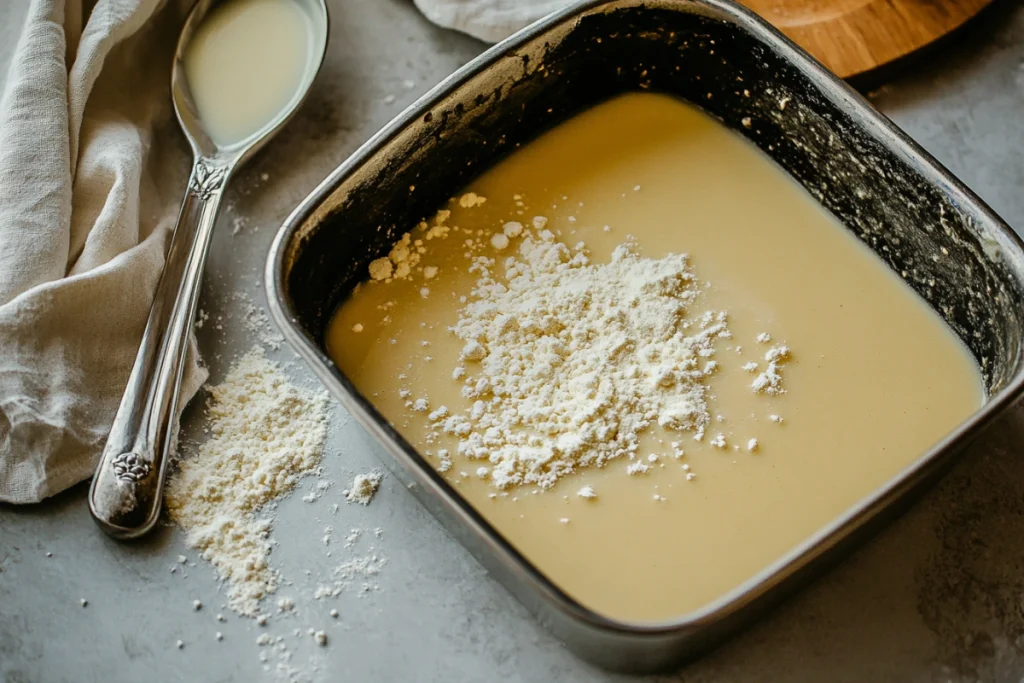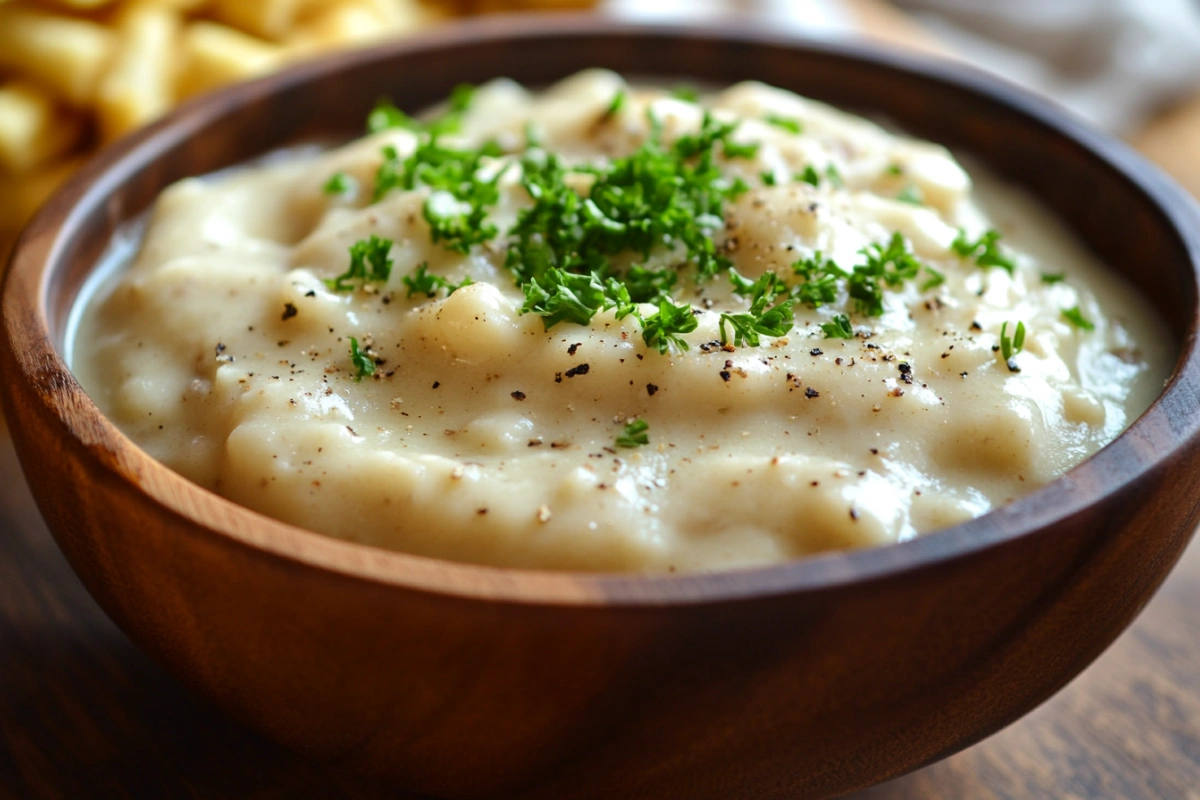Sausage gravy recipe is a classic Southern comfort food that is beloved for its rich, creamy texture and savory flavor. Whether you’re enjoying it over biscuits or other breakfast staples, getting the perfect consistency is key to a great sausage gravy experience. For many, the challenge lies in achieving the right thickness—too runny and it loses its appeal, too thick and it feels too heavy. In this article, we’ll explore the techniques and tricks for making a perfectly thick sausage gravy every time. We’ll dive into the best ingredients, common thickening methods, and tips for avoiding mistakes, so you can create a gravy that’s just right.
1. Key Ingredients for a Perfectly Thick Sausage Gravy Recipe
When it comes to making sausage gravy, the ingredients play a huge role in determining its texture and flavor. A well-balanced blend of ingredients ensures your gravy is thick, flavorful, and rich. Here’s a breakdown of the must-haves and how they contribute to the perfect consistency.
Essential Ingredients
- Sausage: Sausage, especially pork sausage, provides the savory foundation for the gravy. Its fat not only adds flavor but also helps in thickening the sauce. For a lighter version, turkey sausage is a great alternative, but keep in mind it may need additional fat for thickening.
- Flour: Flour is the traditional thickener for most gravies, and it’s essential in creating that smooth, velvety texture. When combined with the sausage fat, it forms a roux, which is key to achieving the perfect thickness.
- Milk: The type of milk you use can influence the consistency. Whole milk adds creaminess and thickness, while skim milk will result in a thinner gravy. Some people prefer using heavy cream for an extra thick and rich texture.
- Seasonings: Salt and pepper are the basics, but you can spice it up with cayenne or paprika to add a bit of kick. Adding a dash of nutmeg or thyme can also introduce some depth to the flavor.
Ingredient Adjustments for Thicker Gravy
Want your gravy to be extra thick? Try these easy ingredient adjustments:
- Using Whole Milk: If you’re not already using whole milk, switch to it. The higher fat content will naturally thicken your gravy.
- Extra Flour: Add an extra tablespoon of flour to your roux if you prefer a thicker consistency.
- Cornstarch Alternative: Cornstarch works as an alternative to flour, especially if you’re aiming for a gluten-free version. However, remember to mix it with cold water before adding it to the gravy to avoid lumps.
2. Thickening Techniques for Sausage Gravy Recipe
Once you’ve got your ingredients prepped, the next important step is using the right methods to thicken your sausage gravy. There are several tried-and-true techniques, as well as a few alternative methods, depending on what you have available. Let’s take a look at some of the most effective ways to achieve the perfect consistency.
The Classic Roux Method
A roux is a mixture of fat (usually from the sausage drippings) and flour. It serves as the base for many gravies and sauces, making it the most traditional thickening method for sausage gravy recipes.
- How to Make a Roux: Once your sausage is browned, don’t drain the fat. Instead, add your flour directly to the pan. Stir it constantly over medium heat until it turns light brown. This is a crucial step because it eliminates the raw taste of the flour and helps create a smooth, thick base for the gravy.
- Adjusting for Thickness: To achieve the perfect thickness, use roughly 2 tablespoons of flour for every cup of liquid. This ratio ensures a rich texture without the gravy becoming too dense. If you want a thicker gravy, slightly increase the flour, but be careful not to overdo it, as it can result in a heavy consistency.
Cornstarch Slurry Method
Another popular method is using a cornstarch slurry. This is especially helpful if you’re short on time or want a gluten-free option for thickening.
- How to Use Cornstarch: Mix 1 tablespoon of cornstarch with 2 tablespoons of cold water until it forms a smooth liquid. Slowly whisk the slurry into your gravy, ensuring there are no lumps. The cornstarch activates with heat, so continue cooking for 2–3 minutes until it thickens.
- Pros and Cons: Cornstarch provides a glossy, silky finish but can sometimes result in a slightly different texture than flour-based gravies. Also, it tends to thicken faster than flour, so it’s best to add it gradually to avoid over-thickening.
Heavy Cream for Extra Richness
If you want your gravy to be extra rich and thick, consider using heavy cream as part of the liquid base. While this method may not be as traditional, it adds a luxurious texture that’s perfect for special occasions.
- How to Add Cream: Substitute part of the milk with heavy cream. Use a 50/50 ratio for a creamier texture, but be mindful of the overall thickness. Heavy cream can make the gravy rich, so balance it out by reducing the amount of flour or cornstarch used for thickening.
By mastering these techniques, you can ensure your sausage gravy turns out perfectly thick and luscious every time. In the next section, we’ll dive into common mistakes that can cause your gravy to turn out too thin or too thick and how to fix them.

3. Common Mistakes and How to Fix Them
Even when following the best sausage gravy recipe, issues with consistency can still arise. From gravy that’s too thin to one that’s too thick and lumpy, several factors can throw off your desired texture. In this section, we’ll explore how to address these common problems and get your sausage gravy just right.
Gravy Too Thin? Here’s How to Fix It
If your gravy comes out runny, don’t worry! It’s a common problem that can be fixed easily.
- Whisk in More Flour or Cornstarch: The most straightforward solution is to add a little more thickening agent. You can mix 1-2 teaspoons of flour or cornstarch with water or broth to create a smooth slurry. Slowly whisk this into the gravy while it simmers, allowing it to thicken gradually. Be sure to stir continuously to prevent lumps.
- Reduce the Liquid: If you prefer not to add any more thickening agents, another option is to let the gravy simmer a little longer. The heat will help evaporate some of the liquid, concentrating the flavors and thickening the gravy naturally. This method is particularly useful if you’re trying to maintain a lighter, less floury texture.
Gravy Too Thick? Here’s How to Thin It Out
On the flip side, sausage gravy can sometimes turn out too thick, making it hard to pour or enjoy over biscuits.
- Add More Milk or Broth: The simplest way to thin out overly thick gravy is by slowly stirring in extra milk, cream, or broth. Start with small amounts and whisk it in until the consistency reaches your desired thickness.
- Be Careful with Flour: If you added too much flour in the beginning, this could be the root cause of the thickness. Always remember to add the flour in small increments while whisking constantly to prevent it from clumping and over-thickening the gravy.
Lumpy Gravy? Smooth It Out with These Tips
Nobody likes lumpy gravy, but it’s a common issue when flour or cornstarch isn’t properly incorporated.
- Strain the Gravy: If lumps have already formed, the easiest solution is to pass the gravy through a fine mesh strainer. This removes the lumps while keeping the flavor and texture intact.
- Use an Immersion Blender: Another option is to use an immersion blender to break down any lumps. Just be careful not to over-blend, as this can turn the gravy too smooth and alter its texture.
Balancing Thickness with Flavor
It’s important to remember that while thickening the gravy, you should also maintain its rich flavor. Adding too much flour or cornstarch can dull the taste. If this happens, consider enhancing the gravy with seasonings like salt, pepper, and a pinch of garlic powder or onion powder to bring back its savory depth.
Now that you know how to troubleshoot common problems with thickness, let’s move on to specific ingredients you can use to elevate both the texture and taste of your sausage gravy.
4. Ingredients to Enhance the Thickness and Flavor
When making a delicious sausage gravy, the ingredients you choose can make a big difference in achieving the right thickness. From the type of fat you use to the specific flour or cornstarch, each component plays a role in both the flavor and texture of your dish. Let’s break down how the key ingredients affect the consistency of your sausage gravy.
The Role of Sausage in Gravy Thickness
The first and most important ingredient in sausage gravy is, of course, the sausage. Different types of sausage can impact how thick the gravy turns out.
- Fat Content: Sausages with higher fat content release more grease, which mixes with the flour to form a roux, the base of the gravy. This creates a thicker texture. Leaner sausages, on the other hand, may need extra butter or oil to achieve the same consistency.
- Spices and Seasoning: Some sausages are more heavily spiced than others. While this won’t necessarily affect thickness, it does influence the flavor profile. Using a well-seasoned sausage can enhance the taste of the gravy, meaning you may not need to add as many additional seasonings later on.
Flour vs. Cornstarch: Which Thickener Works Best?
When thickening your sausage gravy, you’ll typically use flour or cornstarch. Both have their pros and cons, but understanding how each works will help you choose the right one for your recipe.
- All-Purpose Flour: This is the traditional thickener used in most sausage gravy recipes. It not only thickens the gravy but also adds a subtle richness. The trick is to cook the flour long enough in the fat to remove its raw taste before adding liquid. The standard ratio is about 1-2 tablespoons of flour for every cup of liquid, depending on how thick you want the gravy.
- Cornstarch: Cornstarch is a more concentrated thickening agent, meaning you need less of it compared to flour. It also results in a more translucent gravy with a smoother texture. To avoid lumps, always dissolve cornstarch in cold water before adding it to your gravy mixture. It’s ideal for those who want to cut back on the heaviness that flour might add.
Milk, Cream, and Broth: The Liquid Base Matters
The liquid you use also plays a crucial role in the thickness and creaminess of your gravy. Different liquids can lead to varying textures, so let’s explore your options:
- Whole Milk: This is the classic choice for a creamy, rich sausage gravy. The fat content in whole milk helps create a thick, smooth consistency. However, if you prefer a lighter texture, you can use lower-fat milk, but you may need to adjust your thickening agents accordingly.
- Heavy Cream: For those who want an ultra-luxurious gravy, heavy cream is the way to go. Its high-fat content thickens the gravy more easily, creating a velvety texture. You may find you need less flour or cornstarch when using cream.
- Chicken or Beef Broth: While not traditionally used in sausage gravy, broth can be added for extra flavor and a lighter consistency. It’s a great option if you want to reduce the richness of the dish, but keep in mind that broth will produce a thinner gravy unless combined with a thickening agent like flour or cornstarch.
Butter vs. Oil: Which Fat to Use?
Whether you use butter or oil for your sausage gravy can also affect its thickness and flavor.
- Butter: Using butter creates a richer, creamier gravy. The water content in butter can sometimes thin the gravy slightly, but the fat helps in building a roux that binds with the flour for a thicker consistency.
- Oil: Oil can be used as a substitute for butter, especially if you’re using a leaner sausage. However, oil doesn’t add the same richness as butter, so you may need to compensate by adding a bit more cream or milk to balance the flavors.

5. FAQs on Thickening Sausage Gravy Recipe
What can I use instead of flour to thicken sausage gravy? If you’re avoiding flour, you can use cornstarch, arrowroot powder, or even potato starch as alternatives. Just remember to dissolve these in cold water before adding to your gravy to prevent lumps.
Why is my gravy too thick after cooling? Gravy tends to thicken as it cools because the fats solidify and the starches continue to absorb liquid. To fix this, gently reheat your gravy over low heat and add a splash of milk or broth to loosen it up.
How do I avoid lumps when thickening gravy? To avoid lumps, always whisk your flour or cornstarch thoroughly into the fat before adding any liquid. You can also strain the gravy if lumps form.
6. The Step-by-Step Guide to Achieving the Right Consistency
Now that we’ve gone over the key ingredients, it’s time to focus on the cooking process itself. Making a delicious, thick sausage gravy isn’t just about following the recipe. It’s about technique and making adjustments on the fly to ensure the perfect consistency.
Start with Browning the Sausage
The first step in making any sausage gravy recipe is to brown your sausage. This step is crucial because it releases the flavorful fats that will form the base of your gravy. Here’s what you should do:
- Use Medium Heat: Browning sausage on medium heat allows the fat to render without burning. You want the sausage to be fully cooked and slightly crispy around the edges to enhance the flavor of the gravy.
- Break It Apart: As the sausage cooks, use a spatula to break it into small, bite-sized pieces. This ensures that the sausage is evenly distributed throughout the gravy.
Making the Roux
Once your sausage is browned, you’ll want to leave about 2-3 tablespoons of fat in the pan to create the roux, which will thicken your gravy. If there isn’t enough fat, you can add some butter to make up the difference.
- Cook the Flour: Sprinkle your flour over the sausage and fat, stirring constantly to form a roux. Cook the roux for about 2-3 minutes. The goal is to eliminate the raw flour taste while building the base for a thick, creamy gravy.
- Avoid Over-Browning: Be careful not to over-brown the roux. It should have a slightly golden color, but not be too dark. Over-cooking the flour can lead to a bitter taste.
Slowly Add Your Liquid
The next step is to slowly incorporate your liquid, whether that’s milk, broth, or cream.
- Pour Gradually: Slowly pour in the liquid while whisking constantly. This prevents lumps from forming and helps the gravy thicken evenly.
- Whisk Vigorously: Whisking is key to ensuring that the flour and fat mix smoothly with the liquid. As the gravy heats up, you’ll start to see it thicken.
- Adjust the Heat: Keep the heat at medium to avoid boiling the gravy, as this can make it too thick too quickly. A low simmer helps it thicken more gradually, allowing you to control the consistency better.
Let It Simmer
Once you’ve added all of your liquid, let the gravy simmer for about 5-10 minutes. During this time, the gravy will thicken further, and the flavors will meld together.
- Stir Frequently: As the gravy simmers, continue stirring it occasionally to prevent it from sticking to the bottom of the pan and to ensure an even thickness.
- Check Consistency: If the gravy is too thick, add a splash of milk or broth. If it’s too thin, let it simmer for a few more minutes. You can also add a small slurry of flour or cornstarch if necessary, but be sure to dissolve it in cold water first to avoid lumps.
Season to Taste
Once the gravy has reached your desired thickness, it’s time to taste and adjust the seasoning.
- Add Salt and Pepper: Season your gravy with salt and freshly ground black pepper. Taste as you go, as sausage can sometimes be salty enough on its own.
- Optional Spices: You can also add additional spices to suit your taste. A pinch of cayenne pepper or paprika can give your gravy a little extra kick, while a dash of garlic powder adds depth of flavor.
Final Adjustments
At this point, your sausage gravy should be nearly perfect. However, if you want to tweak it further, here are a few tips:
- Too Thick? Add a bit more milk or broth to thin it out.
- Too Thin? Let it simmer longer or add a small amount of cornstarch slurry to thicken it up.
- Lumps Forming? Strain the gravy through a fine-mesh sieve to remove any lumps, then return it to the pan to finish cooking.

7. FAQs on Perfecting Sausage Gravy Recipe
Can you reheat sausage gravy without losing thickness? Yes! To reheat sausage gravy, warm it over low heat, stirring occasionally. If it becomes too thick, simply add a splash of milk or broth to thin it out.
How do you fix gravy that’s too runny? If your gravy is too runny, you can fix it by simmering it longer or adding a small cornstarch slurry. Be careful not to add too much at once, as it can thicken very quickly.
What can I do if my gravy is too salty? If your gravy ends up too salty, add a bit more milk or cream to dilute the saltiness. Alternatively, you can add a pinch of sugar to balance out the flavor.
8. Best Ways to Serve Sausage Gravy
Sausage gravy is traditionally served over biscuits, but there are plenty of creative ways to enjoy this hearty dish. Here are some serving ideas:
Classic Biscuits and Gravy
- Warm, Flaky Biscuits: The most popular pairing for sausage gravy is a batch of warm, flaky biscuits. Split the biscuits in half and ladle the gravy generously over them.
- Buttermilk Biscuits: For the ultimate Southern experience, make your own buttermilk biscuits from scratch. Their slight tang complements the rich flavors of the gravy perfectly.
Other Ways to Enjoy Sausage Gravy
- Over Toast: If you don’t have biscuits on hand, toast can be a quick substitute. Use thick slices of toast to soak up the gravy.
- On Mashed Potatoes: Sausage gravy can also be used as a topping for mashed potatoes, providing a rich, flavorful alternative to traditional gravy.
- With Eggs: Try serving your sausage gravy alongside scrambled or fried eggs for a full breakfast plate.
- On Chicken Fried Steak: Another Southern favorite, chicken fried steak, pairs wonderfully with this type of gravy. The crispy texture of the steak contrasts with the creaminess of the gravy, creating a well-rounded meal.
Storing Leftover Sausage Gravy
Gravy tends to thicken as it cools, but don’t worry — it can be easily reheated to its former glory. Here’s how to properly store and reheat it without compromising flavor or texture:
Refrigeration
- Storing in the Fridge: Leftover sausage gravy can be stored in an airtight container in the refrigerator for up to 3-4 days. Be sure to let the gravy cool completely before transferring it to the fridge.
Freezing Sausage Gravy
- Freezing for Later: If you’ve made a large batch, you can freeze the gravy for up to 3 months. Use freezer-safe containers or bags to prevent freezer burn.
- Thawing and Reheating: To thaw, transfer the gravy to the fridge and let it thaw overnight. When reheating, do so on the stovetop over low heat, stirring frequently. If the gravy is too thick, add a splash of milk or broth to thin it out.
Reheating Sausage Gravy
When reheating sausage gravy, whether from the fridge or freezer, follow these tips:
- Stovetop Method: Reheat the gravy over low to medium heat, stirring occasionally. This method allows for the most even heating and helps maintain the original texture of the gravy.
- Microwave Method: You can also use the microwave, but be sure to stir the gravy every 30 seconds to prevent it from becoming too thick or unevenly heated. Add a splash of milk if necessary to achieve the right consistency.
Conclusion: Mastering Your Sausage Gravy Recipe
In conclusion, mastering the art of making sausage gravy recipe is all about balancing flavors and textures while embracing the creative freedom to adapt the recipe to your taste. Whether you’re using a classic sausage gravy recipe, trying out new thickening techniques, or exploring different ways to serve this comforting dish, the possibilities are endless.
Understanding how to thicken your gravy without compromising flavor can elevate your breakfast or brunch spread, making it a standout dish. From experimenting with thickeners to discovering delightful sides to serve alongside, each step contributes to a heartwarming experience for you and your loved ones.
Don’t hesitate to get a bit adventurous! Try variations like adding spices, herbs, or even vegetables to your sausage gravy for a unique twist. And remember, cooking is all about enjoying the process and making it your own. So, roll up your sleeves, grab your favorite sausage, and get ready to create a sausage gravy recipe that’ll have everyone coming back for seconds.

